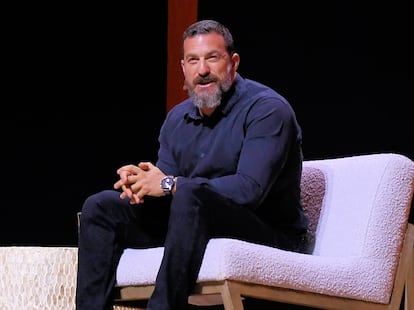Taking care of yourself was a girl thing. The concern for the body and the mind has evoked images of mothers doing aerobics with Eva Nasarre, by influencers like Paula Ordovás drinking kale and chia smoothies or talking about mental health. Dieting was something they did. Men were more likely to talk about how much they drank than how little they ate. The data speaks for itself. According to the College of Dietitians-Nutritionists of the Valencian Community, 87% of its users are women. A study of the Therapyside platform indicates that they represent 69% of patients on therapy. It’s not that they don’t need to take care of themselves: men have shorter life expectancies, drink more, eat worse, and their mental health problems often end in suicide. Wellbeing was a woman’s thing for a simple matter marketing. The industry has developed a language and aesthetic thinking about them. Until things started to change.
The Global Wellness Institute estimates that the global economy of this sector has reached five and a half trillion euros in 2023. And it is believed that this figure will reach almost eight trillion by 2028. To achieve this roaring growth they had to look for new market niches. And to do this they changed the terms and the aesthetics, they made a rebranding thinking about men. Self-care has been renamed biohacking. Meditation, as a cognitive improvement. Stoic behavior has been resorted to, replacing pleasant spas with cold water baths, salad diets with steak-based diets or with spartan intermittent fasting. He created a well being for macho men, with a simple face wash. By filling the gyms with technological devices: glucometers, physical activity meters, calorie counters, pulse oximeters… Wellbeing as a competition, instead of resting and taking care of oneself, it was thought that it would be more masculine to talk about optimization, appealing to the need for control and fulfilment.
And the change worked. More or less.
Emily Contois, sociologist, nutritionist and author of Eaters, kids, and diets: How gender and power collide in media and food culture (without translation into Spanish) explains in an exchange of messages that “there are clear market reasons for creating a male food culture”. That many men are starting to worry about their diet may be good news. But the author believes that this paradigm shift is motivated by economic reasons and regrets that the worst of diet culture, which caused them so much harm years ago, is now being replicated with them.
Daniel Ursúa, dietician-nutritionist at Nutrihabits, agrees with this idea. “Detox shakes are not necessary for women, nor does the paleo diet need to be beneficial for men,” she explains in a message exchange. “Behind both ideas is the same market trying to benefit from the insecurities of others.” These differentiated diets do not have a biological basis, but rather an economic one, experts underline. And weight centrism and restrictive diets are just as harmful, whether they’re aimed at men or women. “Until a change in habits aims to improve long-term health, it will lead to problems in the short or medium term,” adds Ursúa.
This is the consequence, but it would be interesting to understand the cause. To explain what happens to men’s bodies, Contois moves on to analyze the cultural context. “There is increasing social pressure for men to look a certain way,” he reflects. In the first decade of the 21st century, a study warned of the disproportionate and unrealistic growth that children’s action toys were experiencing and highlighted their potential influence in the future. It was precisely in that period that the first superhero films began.
Contois directly cites “the rise of the Marvel Cinematic Universe and its heroes in tight suits,” to explain how the canon of male beauty has changed. Suddenly, bodies with natural fibers were puffy, hyper-defined. Hollywood actors underwent rigorous workouts that they described in magazines, making men around the world believe they could get a body like theirs in just a couple of months. This change has been favored “by the increasingly widespread use of doping substances and testosterone supplements”, underlines the expert, who also cites the popularity of sports such as CrossFit, where “not only strength and endurance are important, but also showing off a shirtless torso”.
But it was social media that most influenced how men perceived their bodies. A recent University of Toronto study linked visual exposure to muscular torsos with dysmorphia issues and low self-esteem in young and adult men. “This type of content is not only available, I would say inevitable on the Internet,” explains Contois, “and it is influencing the way men think about their bodies, what they eat and how all of that shapes the concept of masculinity and what it means to be a man.”
This new performative masculinity is part of a shift in attitudes towards wellness that dates back to 2008, when Gwyneth Paltrow first sent her news From Wellan empire of well being female worth $250 million. Then an important leap was made: previously being healthy was equivalent to not being sick; Now, the idea is that the body is something that must constantly be cared for and improved. Diets began to be presented as ways to eliminate toxins, get more energy, or reduce inflammation. The intestinal flora was intended as a garden that we had to cultivate and care for. Natural foods weren’t natural enough, so they started consuming supplements, vitamins, medicines… This lifestyle was quickly adopted by celebrities, from Hollywood to Silicon Valley, and their choices became a topic of conversation. And so we begin to shape the current context.
The new wellness gurus
Popular people were born from this ecosystem influencers of well being men who respond to the concerns of a new generation of men interested in improving their working and sexual lives and their longevity. It is a genre that has been called, with some condescension “brother science“, a curious mix of ideology, evangelization fitness and obsession with productivity. The most famous is Andrew Huberman, associate professor of neurobiology at Stanford. His podcast, Huberman Lab, has more than 140 million views on YouTube and is a phenomenon in the United States, where there is already talk of ‘Huberman husbands’. In it New York Times They nicknamed it “Goop for them.”
Huberman is a bit like that He-Man in a scientist’s jacket, a bearded, muscular man with a good CV and better oratory. He prophesies a kind of Silicon Valley-style self-help, a pop neuroscience that focuses on lifestyle changes and supplements to work faster and live longer. He often cites studies from peer-reviewed journals and sprinkles his speech with scientific terms like “neuroplasticity,” “norepinephrine,” and “serum cortisol.” But then he recommends activities more typical of an exaggerated shaman than a scientist. According to Huberman, bathing in cold water increases concentration, looking at the sun in the morning makes you sleep better and breathing through your nose, never your mouth, will give you a more harmonious face.

Huberman is not the only one, but he is the best in a long line of histrionic charlatans. Joe Rogan talks about ice baths and sensory deprivation tanks, Tim Ferriss optimizes sleep and sex with supplements. Liver King believes the crisis of modern masculinity could be solved if we all ate more raw organs. Jordan Peterson, if we only ate meat. Many paint their particular ideas about male well-being with far-right and anti-feminist discourse.
In Spain there are also ambassadors of a well being just for them, with little scientific basis. There’s Antonio Moll, who claims he can reverse gray hair and end wrinkles by “reprogramming the subconscious” and with facial yoga exercises. Or Gonzalo Ruiz Utrilla, who has a news in which he talks about seemingly disparate topics such as investing, transhumanism, businesses, immortality and personal development. An impossible cocktail that combines all the concerns of brother science.
It starts with nutrition and health, but behind it there is a whole ideological package, which includes sex, money, conservative politics and transhumanism. “It’s what manosphere “It’s called being a man of valor,” explains Ursúa. “The ideal of masculinity that we want to exalt from these same spaces is that of a man who is successful in business, seductive, strong, analytical and who takes care of his appearance as part of his personal brand”, says the expert.
Putting all content creators who talk about male well-being in this bag would be an understatement. These may be the most extreme examples with the least scientific basis. But the fact that the well being has also been adapted to men which can be good news, not just for the industry. There are serious communicators and a new cultural context that allows new ideas and conversations to emerge. It’s the result of a new masculinity, a world where men can shamelessly apply moisturizers, worry about their mental health or diet, and talk about topics that until recently were taboo, like erectile dysfunction or hair loss.
Maybe be interested in biohacker and immortality is nothing more than a way to face the fear of death. Obsession with CrossFit and intermittent fasting can be a trigger to talk about physical insecurities. And thus share the experiences of a genre that for years has also been bombarded by unrealistic body images. But, unlike the women, she had difficulty talking about its impact.



